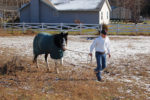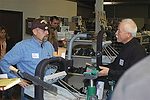Advertise Follow Us
American Farriers Journal

View Archived Issues
November 2009
Volume: 35
Edition: 7
American Farriers Journal is the “hands-on” magazine for professional farriers, equine veterinarians and horse care product and service buyers.
-
Table Of Contents
Table Of Contents
Cash in on Product Sales
Farriers who sell products to clients find it accounts for an average of 12% of their yearly incomeRead MoreBuilding Trust and Build Your Shoeing Business
Hall Of Fame farrier Doug Butler sees this as your best marketing tools with first-time as well as experienced horse ownersRead MoreEducating Horse Owners As Part Of The Job
You can improve your business by letting clients know how they can make it easier to do your jobRead MoreConfidence to Handle High-End Performance Horses
Veteran farriers weigh in on how to improve your confidence for working with moneymaking horsesRead MoreImproving your Farrier Practice
If you want to grow your business, you better be prepared to invest in your education, develop strong customer skills and be ready for self-evaluationRead MoreThe Low-Down on Keeping a Hoof Low
Mirror, Hoofjack and a grinder keep a horse with a locked knee more comfortable and a farrier saferRead MoreIt’s Tough to Do, but Think of Back Pain as Your Friend
It protects you, alerts you to the danger of further injury and makes you move, think and behave differently in your hoof-care workRead MoreDigital Farrier SeriesDefining your Web Site's Mission
Whether your business’s site presents a boilerplate message or is an intricate information source, determine what it should be before creating itRead MoreComplementary Therapies Gaining Wider Use in Hoof Care
Acupuncture, chiropractic adjustments seen as best used in conjunction with more conventional treatmentsRead MoreNutrient StrategiesFeeding the Geriatric Horse
Although horses 20 years and older have special nutritional needs, your clients can keep them healthy through their golden years by paying attention to their special needsRead More












